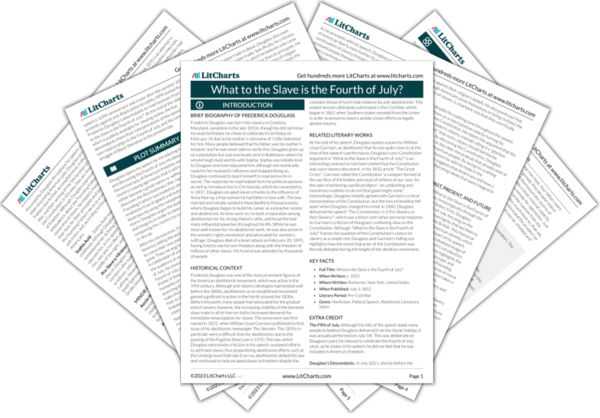Throughout his speech, Douglass often uses the imagery of water to explore different aspects of American history and society. Sometimes, Douglass portrays water as a positive and desirable force. For instance, in the first part of the speech, Douglass compares America to a young river that can still be guided in a positive direction, but is also at risk of drying up if left neglected; in this case, the abundance of water is analogous with America’s flourishing. However, Douglass also uses the destructive potential of water to illustrate the existential dangers facing America, such as when he uses the extended metaphor of a ship having to weather a dangerous storm on the ocean. In this instance, the dangerous storm signifies the scourge of slavery that threatens to “capsize” America’s potential to become a great country. Although Douglass’s contrasting use of water imagery throughout the speech may seem contradictory, it reflects the uncertain state of America’s ideals, which were often appealed to in both positive and harmful ways during the age of slavery.
Water Quotes in What to the Slave is the Fourth of July?
There is consolation in the thought that America is young. Great streams are not easily turned from channels, worn deep in the course of ages. They may sometimes rise in quiet and stately majesty, and inundate the land, refreshing and fertilizing the earth with their mysterious properties. They may also rise in wrath and fury, and bear away, on their angry waves, the accumulated wealth of years of toil and hardship. They, however, gradually flow back to the same old channel, and flow on as serenely as ever. But, while the river may not be turned aside, it may dry up, and leave nothing behind the withered branch, and the unsightly rock, to howl in the abyss-sweeping wind, the sad tale of departed glory. As with rivers so with nations.
At a time like this, scorching irony, not convincing argument, is needed. O! had I the ability, and could I reach the nation’s ear, I would, to-day, pour out a fiery stream of biting ridicule, blasting reproach, withering sarcasm, and stern rebuke. For it is not light that is needed, but fire; it is not the gentle shower, but thunder. We need the storm, the whirlwind, and the earthquake. The feeling of the nation must be quickened; the conscience of the nation must be roused; the propriety of the nation must be startled; the hypocrisy of the nation must be exposed; and its crimes against God and man must be proclaimed and denounced.












